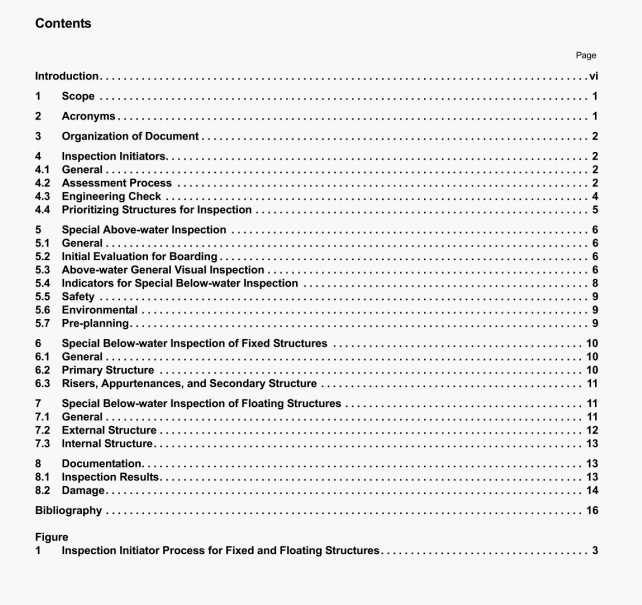API Bull 2HINS:2009 pdf download.Guidance for Post-hurricane Structural Inspection of Offshore Structures.
A special below-water inspection should be performed when the special above-water inspection finds structural damage indicating potential below-water damage, or when the results of the engineering check indicate that the structure could be damaged below-water. The scope and methods of the below-water inspection are dependent upon the findings of the special above-water inspection and/or the results of the engineering check. Guidance for the special below-water Inspection for fixed and floating structures is provided In Section 6 and Section 7.
4.3 EngineerIng Check
4.3.1 General
The engineering check is used to determine if the hurricane may have damaged the structure and a special below- water inspection is required. There are various methods to conduct the engineering check with four methods defined in 4.3.2 to 4.3.5. AddItional methods may be applicable If they can be demonstrated to accurately determine the hurricane conditions in which structural damage is expected. Typically, the engineering checks are performed in the order shown since they become increasingly more complex.
4.3.2 Metocean Condition Companson
This is a check of the observed maximum metocean conditions during the hurricane inclueing wind speed, wave height, current and surge compared to the structure’s design environmental conditions. If al of the hurricane conditions were less than the structure’s design conditions, then the structure passes the engineering check
4.3.3 Load Comparison
4.3,3.1 General
This Is a check of the environmental loads acting on the structure during the hurricane compared to the structure’s design loads The calculated environmental loads should account for direction and occurrence of extreme values of key metocean conditions during the hurricane. The method depends upon if the structure is fixed or floating.
4.3.3.2 Fixed Structures
The load comparison Es typically made using the rnetocean base shear acting on the structure. If the structure is categorized as high consequence 1-i or A-i according to API 2A-WSD. or if the structure is manned-evacuated, then the design load Is used for the comparison. Other fixed structures can use 80 % of the base shear that causes first component failure, If the hurricane loads were less, then the structure passes the engineering check, Single unbraced caissons do not typically require an engineering check (see 5.4.5).
4.3.3.3 Floating Structures
The load comparison is typ.cally conducted by comparing the measured structural response from motions, offsets, mooring line tensions or tendon tensions during the hurricane, where available, to the structure’s design values. If the structure’s response is less than the structure’s design values, then the structure passes the engineering check.
4.3.4 Stress Comparison
This check involves detailed structural analysis of the fixed or floating structure applying metocean conditions equal to or greater than those observed during the hurricane to determine the component stresses in the structure.
API Bull 2HINS:2009 pdf download
